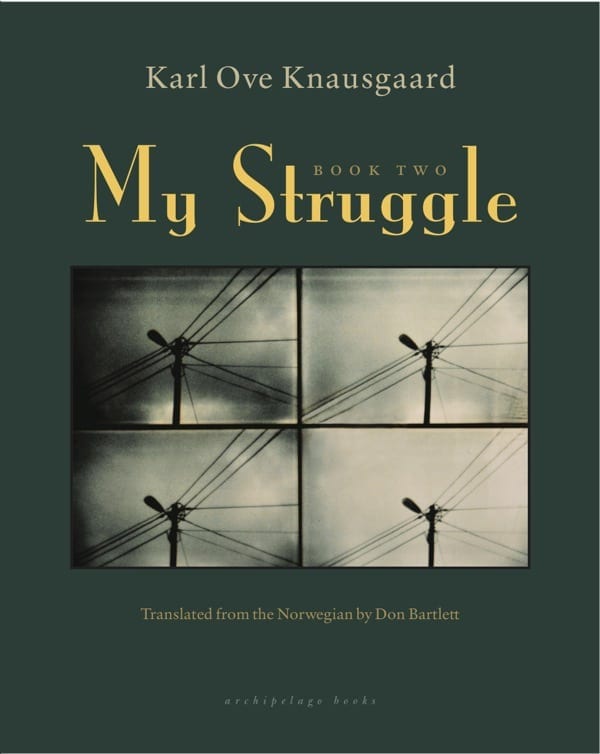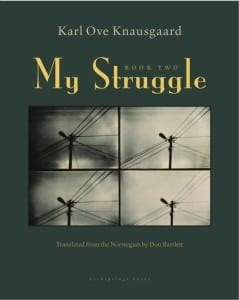
 Download this Reading Guide as a PDF
Download this Reading Guide as a PDF
My Struggle: Book Two
By Karl Ove Knausgaard
Translated by Don Bartlett from the Norwegian
Discussion Questions
1. There is something about the way Knausgaard elevates the everyday to the spiritual that is both enchanting and unsettling. Though Knausgaard told the Paris Review that his series of confessions in the frame of autobiography are not modeled after the thirteen books that comprise The Confessions of St. Augustine, the narrator’s compulsive and voracious need to transform his day-to-day thoughts and unfiltered assessments of the people around him into literature nonetheless feels like a confession. There is something pure, unadulterated and perhaps even religious about this inclusivity. Throughout the novel, Knausgaard churns what’s difficult and painful about everyday life into long, beautiful sentences that invoke both Hölderlin (the poet Knausgaard associates with wholeness and light) and Dostoevsky (the writer Knausgaard links to human wretchedness). As the novel delves into reflections on the author’s self-loathing, we become aware that perhaps Knausgaard senses there’s something perverse and depraved about this relentless candor. We also begin to feel that the author is trying to purge himself of the perverse and depraved. Can the novel be both a meditation on the holy and a confession of great and sin? Consider the moment on page 461 when Geir calls Knausgaard “saint-like.” Is Knausgaard saint-like in his asceticism and his commitment to literature? Would you call this project divine or demonic—or perhaps something else entirely?
2. The publication of the novel, and the unflinching decision to include all of the real names of the people involved, created quite a scandal in Scandinavia. Journalists interviewed dozens of Knausgaard’s friends and family members, a disgruntled uncle threatened to sue him, and his current wife had to come to terms with his shocking portrait of their relationship. The narrative arc of Book Two, in particular, centers around the narrator’s relationship with his partner Linda. The merciless frankness of the novel exposes us to an unsettling, unsentimental and sometimes unflattering portrait of the woman who led Karl Ove to be “a man in love”. According to the Swedish newspaper Dagens Nyheter, Linda had full veto rights to everything he had written about her (though it is unclear whether or not she used them). Even so, when Linda read the novel, she was shocked. Knausgaard explains in an interview with Tim Martin for the Telegraph: “Yes. She said, go ahead. I’m strong, I can take it, but don’t make me a bore. Make me like I am. She was still shocked, though, and it was a real crisis for us. But it was better in the end. “ And yet, for all of his protestations otherwise, it must have been at least a little bit easier to have some distance between his words and the world he inhabits. Volumes one, three, four and five of the series have more to do with Knausgaard’s childhood than his present circumstances, and the gap between his physical and conjured worlds renders the other volumes a little less violent, a little less dangerous. Why is this? Is there something oppressive about narrativizing human interactions that might have otherwise been (or, depending on how you view it, should have otherwise been) unrecorded and unremembered? Especially if the people mentioned are alive and bound to feel a certain way about it? Is creating literature more important than protecting people? Is there anything objectionable about a novel that sounds, looks and smells like a memoir?
3. Much has been made of Knausgaard’s choice of title. My Struggle, or Min Kamp, clearly echoes Hitler’s autobiographical manifesto of the same name. In Book Two, Knausgaard references the German leader in a conversation with his friend and fellow writer, Geir. Geir tells Knausgaard that he has just tried to give a journalist an account of his strict moral code. As the two of them try to construct a personal, literary identity for Knausgaard while sipping beer in Stockholm, they mention the diaries of the poet Olav Hauge. Knausgaard cites Hauge’s over three thousand pages of diary as an influence. Knausgaard tries to explain to Geir that like himself, the poet never stopped wanting to be better. He explains, “[Hauge] fought without cease for the same, for the ideal of how he should be, as compared with the person he was.” Of course, Geir reminds Karl Ove that Hauge also wrote that Hitler was a great man. Knausgaard responds:
But the worst of it is that I can understand: that need to rid yourself of all the banality and small-mindedness…that can create a desire for something pure and great into which you can dissolve and disappear….One people, one blood, one earth. Now precisely this has been discredited once and for all. But what lies behind it, I don’t have any problem understanding that….God knows what I would have done if I’d lived through the 1940s.
Does this reference to an idealism of the self, and this very human understanding of the desire for purity, and the horror that accompanies this, complicate our understanding of Knausgaard’s project of writing and self-amelioration? How does this passage reveal Knausgaard’s own impulses toward simplicity and something higher?
4. Knausgaard’s writing explores a wide range of emotions, and the novel can sometimes feel like a mental map of a man adjusting to a new and unfamiliar world. While falling in love with Linda in the summer months in Stockholm, Knausgaard writes about lightness and wholeness in great detail. We later recognize that this was the peak of his happiness. At his unhappiest, Knausgaard describes family life in terms of cold winter clothes, dreary, life-sucking chores, and the banality of fighting with one’s partner or one’s neighbor. Sweden, a country he found so appealing upon first arrival, becomes a place filled with silly conformists. How does Knausgaard’s writing respond to his mental state? Does his sentence structure or the rhythm of his writing differ depending on the emotion he’s exploring? Do the works of literature he references help us understand how he responds to critical moments in his life?
Further Reading
Online:
Jesse Barron interviews Karl Ove Knausgaard for the piece, “Completely Without Dignity,” published on the Paris Review website.
“Her Struggle is Explosive,” an interview with Linda Knausgaard in the Swedish newspaper, Dagens Nyheter.
The Telegraph’s Tim Martin interviews Knausgaard about controversy and confession in My Struggle on the occasion of the Hay Festival here.
Mark Thwaite explains why My Struggle should be read as a novel and not a memoir in “Knausgaard and Das Unheimliche” on the Ready Steady Book blog.
Daniel Fraser interviews Knausgaard in “The Light Behind the Bookshelves” for 3:AM Magazine.
James Wood introduces an excerpt to the novel on The New Yorker blog.
Read a list of Knausgaard’s favorite books.
Listen to Leonard Lopate interview Knausgaard on WNYC.
Listen to Eleanor Wachtel interview Knausgaard on CBC.
In Print:
Karl Ove Knausgaard, A Time for Everything (Archipelago Books, 2009). This novel follows a young boy who devotes himself to the study of angels.
Marcel Proust, Swann’s Way: In Search of Lost Time, Vol. 1 (Penguin 2004) – One of the first (and finest) examples of memoir as literature.
Knut Hamsun, Hunger (Farrar, Straus, and Giroux, 2008). The novel is a deep and unsettling account of the life and psychology of the writer.
Olav Hauge, The Dream We Carry: Selected and Last Poems of Olav Hauge Copper Canyon Press, 2008). Personal and intentional, Olav Hauge’s poetry lends a sense of comfort to isolation.
Friedrich Hölderlin, Selected Poems and Fragments (Penguin Classics, 1998). Knausgaard associates this German romantic poet and idealist with the supreme.
Fyodor Dostoevsky, The Brothers Karamazov (Farrar, Straus and Giroux, 2002). Knausgaard calls Doestoevsky the novelist with “no divine perspective.”
Saint Augustine, Confessions (Penguin Classics, 1961). These confessions catalog Augustine’s youthful indulgences and their role in his evolution from sinner and atheist to ardent Christian.
Tom Kristensen, Havoc (University of Wisconsin Press, 1968). Knausgaard calls Havoc one of the scariest books he’s ever read about alcoholism and self destruction.
